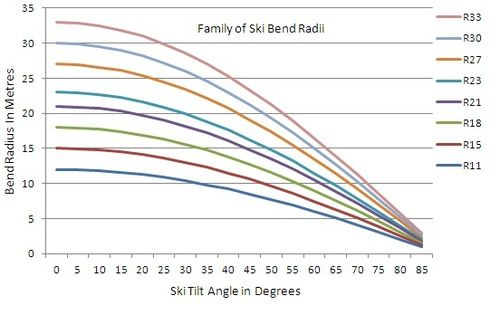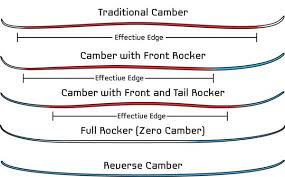 Sports
Sports
 Skiing
Skiing
 Snow Ski Technology
Snow Ski Technology
Don's Home
 Sports
Sports
 Skiing
Skiing
 Snow Ski Technology
Snow Ski Technology
|
|
Early skis were wood and fairly straight with 4 mm sidecut (narrower at the waist than the shoulder and tail) with a little camber (ski bow up underfoot). Ski construction has become very sophisticated over the last 40 years with everything from honeycomb cores to Piezo-ceramics that can convert high frequency mechanical energy to electrical energy. Contents: Sidecut-Shape | Camber-Rocker | Materials-Construction | Books - Links
Sidecut - Shape:
The Kastle slalom used by 1964 medalists Pepi Stiegler, Billy Kidd and Jimmie Heuga had a 6.75 mm sidecut on a 64mm waist. In 1974 head pioneered the concept of a short (180 cm), wide (92.5-71.5-80) ski with more (by standards back then) sidecut (7.3 mm), with the Yahoo. It had a foam core wrapped with fiberglass. It was more for hot dog skiers than racers. I still have my Yahoo 2's and ski them with tele bindings.
In the late 70's and early '80's the Mahre brothers were winning on K2's with a 7 mm sidecut and Ingemar Stenmark used an Elan with 8 mm sidecut, but they were still relatively long (205 cm) skis. In 1992 Kneissl came out with the 180cm Ergo at 100-62-100mm - 19mm of sidecut with a radius of 14 meters. In 1993 Elan introduced "Sidecut Extreme", or "SCX" skis, termed parabolic skis. Their 203cm mold for a GS race ski with a 110-63-105mm profile - that's a 22.25mm sidecut with a radius of just 15 meters In 1994 the K2 Four had a 14 mm sidecut describing a 22 meter radius at the 195cm length. Bode Miller popularized them and shorter larger sidecut skis in general when he started winning FIS races in NH with them in 1995. The disadvantage to a pronounced sidecut is that the ski will be less stable at high speeds, preferring short, quick turns. Also, skis with a drastic sidecut will perform poorly in moguls.
In July 2011 the FIS (International Ski Federation) announced new limits on GS ski minimum length and turning radius to make them safer. About 80 percent of all World Cup racers signed a petition to protest against the changes.
The whole idea is to make it easier to carve a turn without scraping off speed by skidding.
Sidecut Length Turn radius
4.2 mm 83 m
7.3 mm 180 cm 35 m
8 mm 205 cm 41 m
14 mm 195 cm 22 m
22 mm 203 cm 15 m
19 mm 180 cm 14 m
| |||||||||||||
 Graph of bend radius (Calculated by the Howe method) - for eight different skis. Each ski is made with a different fixed sidecut radius (R11, R15 ... R33).
Graph of bend radius (Calculated by the Howe method) - for eight different skis. Each ski is made with a different fixed sidecut radius (R11, R15 ... R33). Longer skis of GS cut are seen to be more responsive (That is change in bend radius resulting from a given change in inclination angle). This can be seen by the slope of the curve for each ski. An edge angle (on the snow) of 60 degrees (cosine = .5) creates a theoretical carving radius of one half the ski's sidecut radius. 75 degrees (cosine = .26) nearly cuts the theoretical carving radius in half again--about one quarter of the ski's sidecut radius When the ski bends into a tighter radius arc than the turn the skier is trying to make, it will not carve--or hold--nearly as well as when tipped to the optimal angle.
Ski Size Chart & Buyer's Guide | evo, 2015
Choosing the Right Ski Waist Width | Switchback Travel Rocker - Camber: 
See: ELAN SKIS | Profiles Materials: You can write a book on ski design. This is a very cursory overview.
Skis were originally made of wood; Hickory and ash were most popular. In the early '70's skis came out with foam cores wrapped in fiberglass. Carbon fiber and aramid (Kevlar and Nomex) became popular later.
At "Materials in Ski Design & Development" - TMS Hugh Casey says,
In 2012 there were 5 kinds of cores for skis: Plastic, Foam, Wood and Wood with Titanium.
See: Books: Skiing Mechanics: John Howe: Amazon.com, 1983
Links: | |||||||||||||